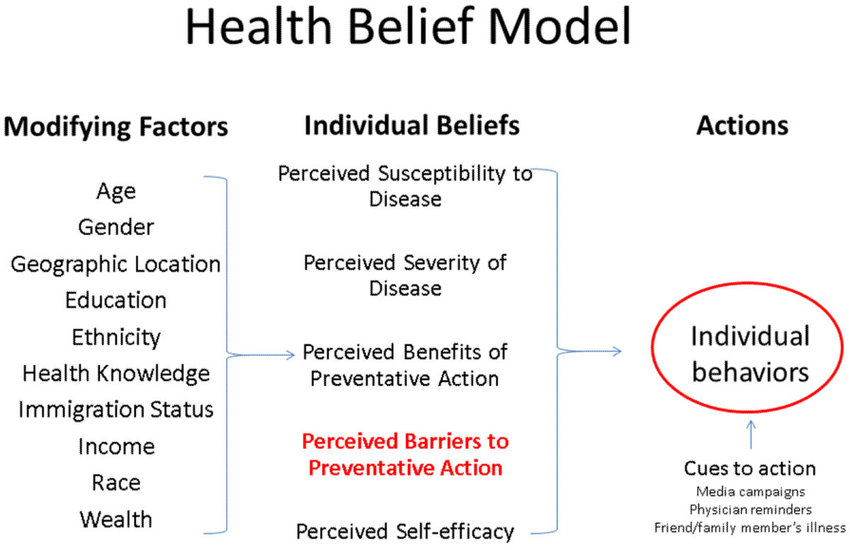The Health Belief Model (HBM) posits that messages will achieve optimal behavior change if they successfully target perceived barriers, benefits, self-efficacy, and threats. It is one of the most widely used conceptual frameworks for understanding health behavior. Developed in the early 1950s, the model has been used with great success for almost half a century to promote greater condom use, seat belt use, medical compliance, and health screening use, to name a few behaviors.
The HBM is based on the understanding that a person will take a health-related action (i.e., use condoms) if that person:
- feels that a negative health condition (i.e., HIV) can be avoided,
- has a positive expectation that by taking a recommended action, he/she will avoid a negative health condition (i.e., using condoms will be effective at preventing HIV), and
- believes that he/she can successfully take a recommended health action (i.e., he/she can use condoms comfortably and with confidence).
The Health Belief Model is a framework for motivating people to take positive health actions that uses the desire to avoid a negative health consequence as the prime motivation. For example, HIV is a negative health consequence, and the desire to avoid HIV can be used to motivate sexually active people into practicing safe sex. Similarly, the perceived threat of a heart attack can be used to motivate a person with high blood pressure into exercising more often.
It’s important to note that avoiding a negative health consequence is a key element of the HBM. For example, a person might increase exercise to look good and feel better. That example does not fit the model because the person is not motivated by a negative health outcome — even though the health action of getting more exercise is the same as for the person who wants to avoid a heart attack.
The HBM can be an effective framework to use when developing health education strategies. A large research study reviewed 46 studies of HBM-based prevention programs published between 1974 and 1984. The HBM-based programs focused on a variety of health actions. The results of the meta-analysis provided substantial empirical support for the efficacy of the HBM. For more information on this study, consult “The Health Belief Model and Personal Health Behavior” (Becker, 1974).
What Are The Major Concepts Of the Health Belief Model?
HBM is based on six key concepts. The following table, excerpted with minor modifications from “Theory at a Glance: A Guide for Health Promotion Practice” (1997), presents definitions and applications for each of the six key concepts. Examples of the concepts as they apply to sexuality education are presented after this table.
| Concept | Definition | Application |
| 1. Perceived Susceptibility | One’s belief of the chances of getting a condition | · Define population(s) at risk and their risk levels
· Personalize risk based on a person’s traits or behaviors · Heighten perceived susceptibility if too low |
| 2. Perceived Severity | One’s belief of how serious a condition and its consequences are | · Specify and describe the consequences of the risk and the condition |
| 3. Perceived Benefits | One’s belief in the efficacy of the advised action to reduce the risk or seriousness of the impact | · Define action to take — how, where, when
· Clarify the positive effects of the expected · Describe evidence of effectiveness |
| 4. Perceived Barriers | One’s belief in the tangible and psychological costs of the advised behavior | · Identify and reduce barriers through reassurance, incentives, and assistance |
| 5. Cues to Action | Strategies to activate “readiness” | · Provide how-to information
· Promote awareness · Provide reminders |
| 6. Self-Efficacy | Confidence in one’s ability to take action | · Provide training, guidance, and positive reinforcement |
For examples of what the six key concepts look like when applied to two sexual health actions, review the following table:
| Concept | Condom Use Education Example | STI Screening or HIV Testing |
| 1. Perceived Susceptibility | Youth believe they can get STIs or HIV or create a pregnancy. | Youth believe they may have been exposed to STIs or HIV. |
| 2. Perceived Severity | Youth believe that the consequences of getting STIs or HIV or creating a pregnancy are significant enough to try to avoid. | Youth believe the consequences of having STIs or HIV without knowledge or treatment are significant enough to try to avoid. |
| 3. Perceived Benefits | Youth believe that the recommended action of using condoms would protect them from getting STIs or HIV or creating a pregnancy. | Youth believe that the recommended action of getting tested for STIs and HIV would benefit them — possibly by allowing them to get early treatment or preventing them from infecting others. |
| 4. Perceived Barriers | Youth identify their personal barriers to using condoms (i.e., condoms limit the feeling or they are too embarrassed to talk to their partner about it) and explore ways to eliminate or reduce these barriers (i.e., teach them to put lubricant inside the condom to increase sensation for the male and have them practice condom communication skills to decrease their embarrassment level). | Youth identify their personal barriers to getting tested (i.e., getting to the clinic or being seen at the clinic by someone they know) and explore ways to eliminate or reduce these barriers (i.e., brainstorm transportation and disguise options). |
| 5. Cues to Action | Youth receive reminder cues for action in the form of incentives (such as pencils with the printed message “no glove, no love”) or reminder messages (such as messages in the school newsletter). | Youth receive reminder cues for action in the form of incentives (such as a key chain that says, “Got sex? Get tested!”) or reminder messages (such as posters that say, “25% of sexually active teens contract an STI. Are you one of them? Find out now”). |
| 6. Self-Efficacy | Youth receive training in using a condom correctly. | Youth receive guidance (such as information on where to get tested) or training (such as practice in making an appointment). |
What Are Some Example Of the Health Belief Model?
The Michigan Model for Health™ is a curriculum designed for implementation in schools. It targets social and emotional health challenges including nutrition, physical activity, alcohol and drug use, safety, and personal health, among other topics. This model adapts components of the Health Belief Model related to knowledge, skills, self-efficacy, and environmental support.
How is the Health Belief Model applied?
The Health Belief Model can be used to design short- and long-term interventions. The five key action-related components that determine the ability of the Health Belief Model to identify key decision-making points that influence health behaviors are:
- Gathering information by conducting health needs assessments and other efforts to determine who is at risk and the population(s) that should be targeted.
- Conveying the consequences of the health issues associated with risk behaviors in a clear and unambiguous fashion to understand perceived severity.
- Communicating to the target population the steps that are involved in taking the recommended action and highlighting the benefits of action.
- Providing assistance in identifying and reducing barriers to action.
- Demonstrating actions through skill development activities and providing support that enhances self-efficacy and the likelihood of successful behavior changes.
These actions represent key elements of the Health Belief Model and can be used to design or adapt health promotion or disease prevention programs. The Health Belief Model is appropriate to be used alone or in combination with other theories or models. To ensure success with this model, it is important to identify “cues to action” that are meaningful and appropriate for the target population.
What Are The Limitations Of The Health Belief Model?
There are several limitations of the HBM which limit its utility in public health. Limitations of the model include the following:
- It does not account for a person’s attitudes, beliefs, or other individual determinants that dictate a person’s acceptance of health behavior.
- It does not take into account behaviors that are habitual and thus may inform the decision-making process to accept a recommended action (e.g., smoking).
- It does not take into account behaviors that are performed for non-health-related reasons such as social acceptability.
- It does not account for environmental or economic factors that may prohibit or promote the recommended action.
- It assumes that everyone has access to equal amounts of information on the illness or disease.
- It assumes that cues to action are widely prevalent in encouraging people to act and that “health” actions are the main goal in the decision-making process.
The HBM is more descriptive than explanatory and does not suggest a strategy for changing health-related actions. In preventive health behaviors, early studies showed that perceived susceptibility, benefits, and barriers were consistently associated with the desired health behavior; perceived severity was less often associated with the desired health behavior. The individual constructs are useful, depending on the health outcome of interest, but for the most effective use of the model, it should be integrated with other models that account for the environmental context and suggest strategies for change. ALSO READ: Who developed the social cognitive theory?





